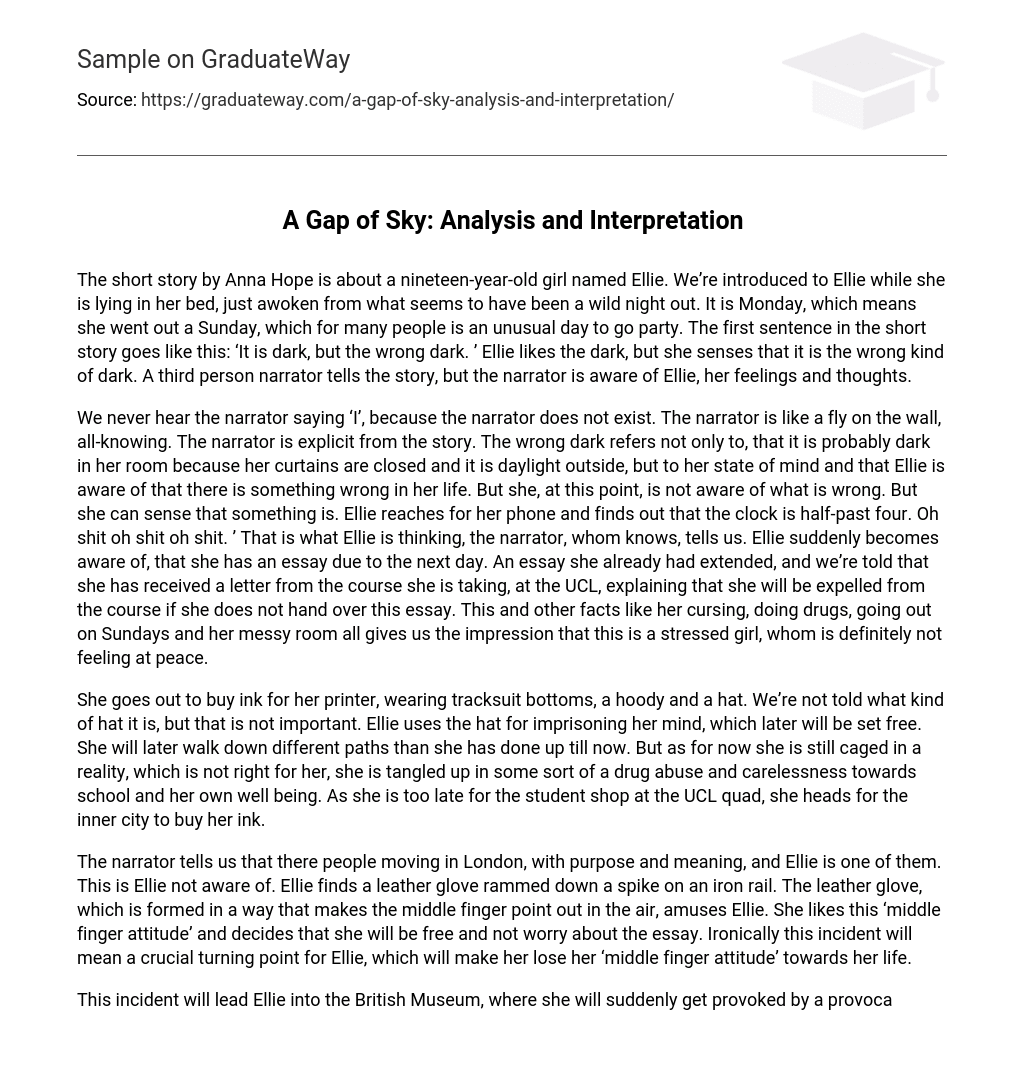The short story written by Anna Hope revolves around a nineteen-year-old girl named Ellie, who is found lying in her bed after what appears to be a wild night out. It is specifically mentioned that it is Monday, implying that Ellie chose to go out on a Sunday, an unconventional day for most people to party. The opening line of the story reads, ‘It is dark, but the wrong dark,’ indicating that while Ellie typically enjoys darkness, she senses that this particular darkness feels unsettling. Although the story is narrated in the third person, the narrator possesses knowledge about Ellie’s emotions and thoughts.
The story’s narrator observes from a fly-on-the-wall perspective, never using the pronoun ‘I’. The darkness mentioned encompasses both Ellie’s dimly lit room and her troubled state of mind. Although Ellie senses something amiss, she remains unaware of the specific issue. As she glances at her phone and sees that it’s already half-past four, panic fills her thoughts. The narrator, privy to Ellie’s innermost musings, shares her realization that an essay is due the following day. This essay has already received an extension, and Ellie has received a letter from her UCL course warning of expulsion if she fails to submit it. Additionally, the narrator points out other details like Ellie’s use of foul language, drug consumption, and disorganized room – all signs pointing to a stressed and troubled young girl.
Ellie, dressed in tracksuit bottoms, a hoody, and a hat, goes out to purchase ink for her printer. Although the specific type of hat is not mentioned, it is not a significant detail. The hat serves as a metaphor for imprisoning her mind, which will later be liberated. Ellie will embark on different paths in the future compared to her current circumstances. However, she is currently confined within a reality that is not suitable for her. She finds herself entangled in drug abuse and a lack of concern for both school and her own well-being. Since she missed the student shop at the UCL quad due to being late, she heads towards the inner city to buy the ink instead.
The narrator describes the bustling movement of people in London, including Ellie. However, Ellie is oblivious to this. One day, she discovers a leather glove stuck on an iron rail, with its middle finger sticking out. This sight amuses Ellie and she admires the rebelliousness it represents. Inspired, she decides to liberate herself and not worry about an essay she has to write. Ironically, this incident will later lead to a significant change in Ellie’s outlook on life, causing her to lose her rebellious spirit.
This incident causes Ellie to enter the British Museum, where she encounters a thought-provoking exhibition featuring numerous pills displayed in cases with a sign reading ‘Living and Dying’. In this moment, she removes her hat, exposing herself to external influences and opening her mind. The exhibition deeply affects Ellie, as it reminds her of ‘the wrong dark’ and stirs her fear of death. Consequently, she no longer wishes to remain at the exhibition and seeks to distance herself from that dismal phase of her life.
Ellie desires a purposeful existence and recognizes that her present course will not bring about triumph. She is uncertain about composing an essay and pledges to quit using cocaine from this moment forward. Ellie’s sole aspiration is to go for a stroll, yet unbeknownst to her, she inadvertently embarks on a voyage of self-exploration while heading towards the city center. In an enthralling twist of fate, just as Ellie ponders seizing life’s opportunities, a shop door opens and casts light upon the darkening street.
Ellie goes into a shop and discovers stones that remind her of the one her mother had given her, which was meant to bring her protection. Back then, Ellie didn’t grasp its importance, but now she wishes she had valued it more. The sight of these stones evokes feelings of longing for her mother, whom she used to blame for enrolling in this literature class. However, Ellie’s perspective has shifted and she no longer harbors any negativity towards the course. On the contrary, it has revitalized her and brought joy into her life. She no longer feels constrained by stress or indifference.
Ellie has matured and discovered her capacity to appreciate things. Motivated to prove this newfound ability to her mother, she sets out to write an essay. The city serves as a symbolic representation of Ellie’s personal growth and current stage in life. Beginning in a foul-smelling and disorderly apartment, one can almost perceive the dense and oppressive ambiance that engulfs the space. Similar to her living conditions, Ellie herself seems trapped in a fog, lacking control over her own existence. However, when she visits the museum, she leaves behind her previous self, opting for a more appropriate setting since museums house antiquities and old objects.
As Ellie journeys towards the city’s core, she simultaneously embarks on a path of self-discovery. Nevertheless, these transformations are sparked by chance encounters like stumbling upon a leather glove. Without witnessing the leather glove, Ellie might never have ventured into the museum and experienced her epiphanies. Even if the museum had not hosted that particular exhibition, she may still have remained oblivious to her own growth. While some argue that it is predetermined fate, I personally reject such notions. Instead, I view it as an illustration of how unforeseen incidents, beyond our influence, possess the power to profoundly shape our lives.





